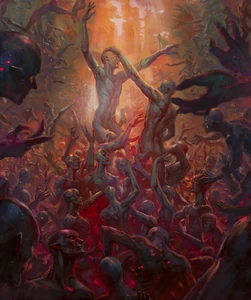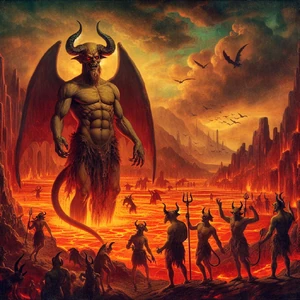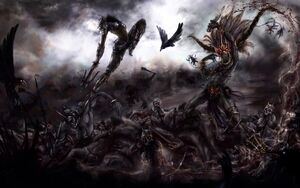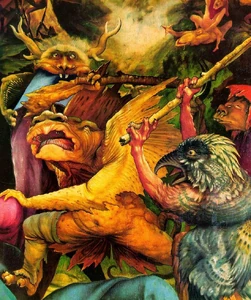Demons, are very common antagonists in a number of theological stories, mythologies, folklore, and fiction. They are possibly considered either Fallen Angels, Unclean Spirits or degenerated Lesser Gods. Although the word now has an attachment to malevolence it was originally a neutral term for any spirit lesser than a deity in status but higher than humans.
Description[]
Out with religion demons are seen as metaphors for natural disasters, affliction, and cruelty, the most prominent of which are the "deadly sins" of Christian tradition. Demons are also used to describe inner fears and anxieties found in the minds of all people, which is where the common expression "face one's demons" comes from.
Demons are similar to monsters in being frightening and against the natural order. Unlike monsters, however, most demons are seen as a spiritual threat rather than a physical one and can possess humans, cause poltergeist activity, drive people insane, and much more.
History[]
Biblical Tales[]
Demons in the Bible are otherwise known as fallen angels.
They are led by their ruler Satan to oppose God's will on Earth by warring against His angels and followers. Their numerous offenses include influencing/possessing human beings into doing their evil works, spreading false doctrine and lies, and producing the Nephilim, a monstrous race of giants. Those directly responsible for creating the Nephilim were imprisoned in Tartarus whilst others appeared to roam free. God eventually condemns them to the Lake of Fire, along with their ruler. Examples of demons in the Bible include Legion.
Islamic Tradition[]
Demons in Islam are known as Shayatin. The Shayatin are led by Iblis to corrupt as much of humanity from God's path as possible, trying to corrupt humans into immorality. Both humans, as well as Jinn, can become Shayatin. Some of the Jinn don't do evil and mischief and worship God as humans do, so they are not considered demons. Further, the offspring of Iblis are said to be born as Shayatin and always evil. The Jinn on the other hand can be good and avoid hell, but the evil ones among them will be sent to hell along with the evil humans due to their evil, for eternity.
Iblis is a Shaitan who is the Islamic counterpart to Satan. Iblis is an evil Shaitan who tries to corrupt people into evil. But, the good, obedient people refuse the temptation of Iblis. Iblis will eventually be sent to hell along with the evil people who follow his temptations.
, are a type of demon or goblin. Rakshasas have the power to change their shape at will and appear as animals, as beasts, or in the case of the female demons, as beautiful women. They are most powerful in the evening, particularly during the dark period of the new moon, but they are dispelled by the rising sun. They especially detest sacrifices and prayer. Most powerful among them is their king, the 10-headed Rāvaṇa (q.v.). Pūtanā, a female demon, is well known for her attempt to slay the infant Krishna by offering him milk from her poisoned breast; she was, however, sucked to death by the god.
In Buddhist Belief, demons can be driven away or subdued by invoking the power of Buddha, the dharma (the Buddhist teachings), and various other rituals and mantras. In many cases, the demon is seen as a powerful symbol of evil, accompanying the Buddha on his path
Temptation of Buddha[]
The story of the temptation of the Buddha is an important part of Buddhist mythology and can be found in many Asian cultures. As the story goes, shortly after Siddhartha Gautama (the Buddha) had achieved enlightenment, he was confronted with a tempter they called Mara. Mara was a Deva, a deity of sorts, and was curious to see what this new 'enlightened one' would do. He wanted to test Siddhartha's mettle and see if he would succumb to temptation.
Mara offered Siddhartha wealth, pleasure, power, and authority if he would only admit that he was not, in fact, enlightened. Mara had many different physical forms and brought out powerful seductive forces to persuade the Buddha. She showed him images of beautiful women, enchanting music, and imaginary armies of cold, silver warriors. He offered Siddhartha a throne of gold and jewels, and promised him control of the world.
But the Buddha was unmoved. He knew that Mara's offers were false and fleeting, and he reiterated his commitment to the path of the Bodhisattva. He was deeply aware of the dangers of letting himself be swayed by Mara's temptations and instead chose to turn away from them. Mara's temptations only strengthened the Buddha's commitment to the path of compassion and selflessness and was a key step in his journey to Enlightenment.
Chinese Mythology[]
Demons in Chinese mythology are particularly feared in China for their destructive powers and the potential harm they can cause. In essence, demons in Chinese mythology are seen as supernatural forces that can cause physical destruction or psychological harm.
While some Chinese demons are merely perceived as dark agents of destruction, others are said to embody power and strength. These demons range from being evil spirits, like the nine-tailed fox or the horned dragon, to more mystical creatures like the phoenix and the qilin. Chinese demons are also said to be able to foretell the future and shape destiny, hence why they are often seen as having a special spiritual power. Ultimately, Chinese demons are seen as powerful and often feared entities that can bring both destruction and protection, depending on how they are used.
Greek Mythology[]
Demons in Greek are referred to as Daemons and sometimes refer to the Greek gods due to their more questionable actions.
Japanese Mythology[]
Japanese mythology is full of spirits, some of which are considered malevolent in regard to mortals. Unlike Western mythology, Japanese spirits are not really good or evil and are rather bizarre and often alien creatures whose methods and goals are often beyond the understanding of humans. Some of the more prominent demons in Japanese Mythology are the Onis and Tengus.
Celtic Mythology[]
The Fomorians from Celtic Mythology are often envisioned as evil spirits. Though they are technically deities as much as Tuatha de Danann in the same vein with Titans and Jötnar, they share a lot in common with demons, however, in being ugly, malevolent, and residing in the ocean (which is often considered the home of evil spirits).
Folk Tales[]
Folk Devils[]
A Folk Devil is a common antagonist in folklore and myth, often envisioned as the classical satyr-like Devil of Christian lore (inspired by Pan of Greek mythology). A Folk Devil is often a trickster or tempter who is often tricked himself by a seemingly hapless would-be victim.
Although Folk Devils tend to be defeated, there are some variations of the theme in which Folk Devils actually succeed in their plan. A Folk Devil can be seen, in many ways, as an extension of pagan beliefs in fairies and lesser gods, which were gradually replaced by the "Devil" as Christianity spread across the world.
Witchcraft Cults[]
As Christianity spread, the old pagan beliefs were demonized, and their followers accused of being part of "Witchcraft Cults". In the minds of medieval scholars, the world was inhabited by evil-minded men and women who sold their souls to demons in exchange for power, and moral panics often broke out as communities believed they were under attack by these "witches", leading to terrible oppression (such as Witch-Hunts).
Fairies[]
Prior to Christianity, many pagans believed in "fairies", who were lesser-gods or spirits of nature, as Christianity spread the idea that these lesser-gods and spirits were not in line with the strictly monotheistic Abrahamic religions, and thus, the fairies were either declared to be angels, figments of the imagination, or evil spirits that existed to lead people astray. Like Baal and Pazuzu before them, the Fairies suffered a degeneration from lesser-gods and spirits to demons, though some particularly malevolent fairies (such as Redcaps) were always considered demons, even in pre-Christian societies (though they went by different names and appearances).
Circle of Hell Map[]
Limbo[]
Limbo was the first Circle of Hell. It is the residence of the Virtuous Pagans and Unbaptized Souls. Prior to guiding Dante, Limbo was also the residence of Virgil's spirit.
Lust[]
Below Limbo was the second circle, Lust. In this circle, the carnal Damned are punished in an endless tempest of fierce winds, representing the power of Lust to blow one around aimlessly and needlessly. These shades are permitted no rest at all, the tempest being a physical embodiment of their lusts never giving them rest in life. Cleopatra, who ruled over the shades atop the Carnal Tower, resided here with her lover Marc Anthony.
Gluttony[]
Below Lust was the third circle, Gluttony, where the overindulgent souls laid in a vile slush produced by unceasing, foul and icy rains forever. The rains and sludge symbolized the cold and empty sensuality of their lives, and the waste that their voraciousness generated. The rest of the terrain resembled digestive organs, in keeping with the aesthetics of the circle.
This level was guarded by the three-headed guard dog, Cerberus. Beyond him was the circle proper, as well as the Hall of Gluttons. This frozen, maze-like hall was reserved for those of royalty and high status, who indulged in food and drinks to gross excess in life. In death, they are constantly devoured and excreted by several Gluttons for eternity.
Greed[]
Below Gluttony was the fourth circle, Greed. Those whose attitude toward the material goods deviated from the appropriate mean are Geryon punished here. This included the avaricious (hoarding valuable possessions and money) and the prodigal (those who squandered such goods). Within the circle, the occupants are boiled alive in the Charon molten gold below. Here, Plutus, the demonic God of Wealth, resides along with Lady Fortune, a gigantic "wheel of fortune," which impacts the fate of those who are still alive on Earth.
Anger[]
Below Greed was the fifth circle, Anger. In the River Styx, the wrathful fought each other on the surface. The sullen are sunken gurgling beneath the water, as they are withdrawn "into a black sulkiness which could find no joy in God or man or the universe." This swampy and noxious terrain was guarded by its ferryman, Phlegyas, who transported passengers across. Beyond the river was the City of Dis, which was the residence of the Fallen Angels and the gateway to the final four circles of Hell.
Heresy[]
Below Anger was the sixth circle, Heresy. In this circle, the Underworld heretics, such as Epicureans (those who believed that "the soul City of Dis died with the body") are trapped alongside those who denied the existence of God and the soul after death, and those who worshiped false idols and devils. In this burning cemetery, the Pagans, Medusa the followers of Epicurus and atheists are burned alive in partially sealed coffins, crypts and tombs for eternity.
Violence[]
Following Heresy was the seventh circle, Violence. This circle Greek Mythology, Harpy was guarded by the Minotaur (a mechanical statue in the game) and separated into three parts: Violence against others (Murder), Violence against self (Suicide) and Violence against God (Blasphemy). Those who acted with violence against others are boiled in a boiling river of blood, the Phlegethon, which was guarded by the Centaurs. These creatures kept those who are trapped within the Phlegethon from escaping. Those who committed suicide or violence against themselves are placed in the Wood of the Suicides, condemned to writhe in eternal pain as gnarled trees. As a penalty for having given their old bodies up, they are denied a human form in death. Finally, those who showed violence against God are placed in the harsh region of the Abominable Sands. This area includes those who are guilty of sodomy, perversion of Nature and blasphemy against God. They are condemned to wander among the burning sand dunes, as the flaming brimstone rained down upon them.
Fraud[]
Below Violence was the eighth circle, Fraud. Fraud was an extremely dark place that held those who are guilty of deliberate, knowing evil: using lies and deception for personal gain. This circle was divided into ten ditches, known collectively as the Malebolge (singular bolgia, meaning "ditch" or "pit"). Each of the Malebolge held a different type of liar, and a different and appropriately poetic form of punishment.
Treachery[]
Finally, beneath Fraud was the ninth circle, Treachery. This was the farthest place in all of creation from the light of God. It was located at the Earth's core, and was the deepest and blackest of all of the circles. This was where the traitors are distinguished from the "merely" fraudulent. Their acts involved betraying family, community, guests and God Himself. Alongside the traitors, the Giants of myth are condemned here, guarding the entrance to the circle for their daring to battle against the divine. Due to such an extreme absence of Love among these sinners, there is no warmth here, and the circle was depicted as a large, frozen lake holding the traitors captive within the ice. At the very center of Treachery, Lucifer is trapped at the very center of Lake Cocytus, frozen from the waist down. The futile beating of his wings caused an icy wind, which, combined with the tears he sheds, only serve to trap him in the ice further along with his fellow traitors.
List Of Members[]
Prominent Demons Abrahamic theology[]
- Lucifer/Satan - chief of demons in Christianity and enemy of God/Jesus/Mankind.
- Antichrist- the enemy of Jesus who is said to surface in the End of Days.
- The Beast - the "false prophet" and a vessel for Satan to enforce his will during the Apocalypse.
- Whore of Babylon - a female entity who serves Satan.
- Lilith - the original wife of Adam turned succubus.
- Iblis - chief of demons in Islam.
- Beelzebub - a high-ranking demon prince often confused with Satan.
- Samael - an evil angel in Judaism.
- Belial - a crowned prince of hell.
- Mephistopheles - legendary devil from the tale of Faust.
- Mammon - embodiment of avaricious wealth/greed, often seen as a false idol.
- Stolas - a demon own prince who commands twenty-six legions.
- Belphegor - prince of Hell.
- Abaddon - fallen angel of destruction.
- Baal - false god & king of Hell.
- Asmodeus - prince of Hell.
- Paimon - king of Hell.
- Buer - president of Hell.
- Ars Goetia - The 72 highest-ranking demons that serve Lucifer/Satan. This group includes Belial, Stolas, Baal , Asmodeus, Paimon and Buer.
- Leviathan - a sea like behemoth who resides in hell.
- Behemoth -a giant demon.
- Behemoth the Elephant - an elephant demon.
- Baphomet - goat-headed demon who is heavily associated with the occult.
Demons from other folklore[]
- Ravana - a powerful demon from Hindu mythology.
- Mara - chief spirit of evil in Buddhism.
- Surtur - a fire giant from Norse mythology.
Creatures Considered Demons[]
- Hags - evil witch-like beings in folklore/mythology.
- Ogres - sometimes the japanese onis are often considered demons.
- Imps - mischievous little spirits often considered low-ranking demons.
- Fallen angels - angels that have fallen from the grace of God (or similar deity).
- Succubi - female spirits that seduce sleeping males.
- Incubi - male spirits that are accused of raping sleeping females.
- Poltergeist - "noisy spirit". Although a ghost, it can be seen as a demon by some.
Demons In Fiction[]
- Pazuzu - the main antagonist of The Exorcist series.
- Damien Thorn - the main antagonist of The Omen series.
- Chernabog - the main antagonist of Disney's Fantasia.
- Freddy Krueger - the main antagonist of the A Nightmare on Elm Street series.
- Rosemary's Baby - the unnamed main antagonist of Rosemary's Baby.
- Demonic Toys - the titular main antagonists of the "Demonic Toys" series.
- Ghoulies - the titular main character antagonists of the "Ghoulies" series.
- Trigon - a powerful demon from DC universe and enemy of the Titans.
- Blaze - a villain from DC comics and the daughter of the wizard.
- Mephisto - a devil-like figure from Marvel comics.
- Blackheart - the Son of Mephisto from Marvel Comics.
- Kil'jaeden - the secondary main antagonist of the Warcraft series.
- Diablo - the titular main antagonist of the Diablo series.
- Sauron - the main antagonist of the Middle-earth legendarium.
- Morgoth - the overarching antagonist of the Middle-earth legendarium.
- The Beldam - the main antagonist of Coraline.
- Odio - King of Demons and the mastermind behind all evil in Live A Live.
- Violator - The arch-enemy of Spawn.
- Malebolgia - One of the primary antagonists of Spawn.
- Mammon - The version of Spawn.
- Satan- The Spawn version and God's twin brother.
- Phlebiac Brothers - Violator's younger siblings.
- Bingo - a Demon from the Spawn comics.
- Hellion aA Demon from the Spawn comics.
- Hellspawn - a race of Demons made by Malebolgia and Violator.
- Thamuz - a demon from the Spawn comics.
- Ab - a demon from the Spawn Ccmics
- Zab -a demon from the Spawn comics.
- Monsters - The demons from the Doom games.
- Overlords of Hell
- Alastor - from Hazbin Hotel.
- Vox - from Hazbin Hotel.
- Velvette - from Hazbin Hotel.
- Valentino - from Hazbin Hotel.
- Sir Pentious - from Hazbin Hotel.
- The Egg Boiz - from Hazbin Hotel.
- Cherri Bomb - from Hazbin Hotel
- Carmilla Carmine - from Hazbin Hotel
- Katie Killjoy - from Hazbin Hotel.
- Helsa Von Eldritch - from Hazbin Hotel.
- Blitzo Buckzo from Helluva Boss.
- Loona from Helluva Boss.
- Millie from Helluva Boss.
- Moxxie Knolastname from Helluva Boss.
- Aion - the main antagonist of Chrono Crusade series.
- Sinners - the major antagonists of Chrono Crusade series.
- Apostles - the major/minor/supporting antagonists of Berserk series.
- Femto - the main antagonist of Berserk series.
- God Hand - the main antagonists of Berserk series.
- Zodd - a major antagonist of Berserk series.
- Band of the Hawk - major antagonists of Berserk series.
- Idea of Evil - the unseen main antagonist of Berserk series.
- Demons - the major/minor/supporting antagonists of Devilman series.
- Zennon - the main antagonist of Devilman series.
- Satan - the final main antagonist of Devilman series.
- Muzan Kibutsuji - the main antagonist of Demon Slayer series.
- Ao Oni - A mysterious man-eating demon and the main antagonist of the RPG horror game of the same name.
- Chara - A major antagonist in the indie RPG games Undertale and possibly Deltarune.
- Bendy - The main antagonist of Bendy And The Ink Machine.
- Scarlet King - The main antagonist of the SCP mythos.
- Truckenstein - The main antagonist of the Robotboy episode "The Curse of Truckenstein".
- Clown - The main antagonist of Play With Me.
- Antisepticeye - Main antagonist of Jacksepticeye's YouTube channel.
- Diablo - The main antagonist of Primal Rage.
- Lucifer - The main antagonist of Helltaker.
- Kane - A villain from WWE who is the brother of The Undertaker.
- Anubis - The main antagonist of the 2004 movie Yu-Gi-Oh!: The Pyramid Of Light.
- Black Hat - Main antagonist of the Cartoon Network multiverse.
- Ganondorf - Main antagonist of The Legend Of Zelda franchise.
- Archons - Supporting antagonists in the universe of the SCP Foundation.
- Specimen 5 - A major antagonist from Spooky's Jumpscare Mansion.
- Specimen 8 - The eighth guard from Spooky's Jumpscare Mansion.
- Specimen 9 - The final boss of Spooky's Jumpscare Mansion.
- Specimen 11 - The eleventh guard and a major antagonist in Spooky's Jumpscare Mansion.
- SCP-XXXX - Keter class SCPs from SCP: Blackout.
- Destoroyah - The main antagonist of the 1995 Godzilla film Godzilla vs Destoroyah.
- Look-See - Main antagonist of the series of the same name.
- Skitzo - Main character of the COMICK Youtube channel.
- Cartoon Cat - A urban legend created by Trevor Henderson.
Gallery[]
[]
| | ||
|
Main Icons Others | ||




